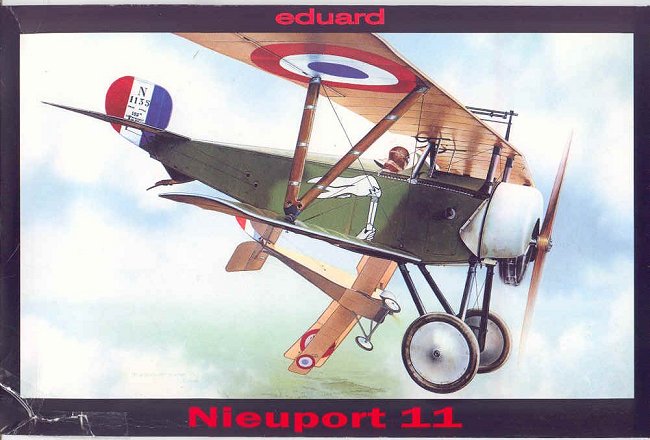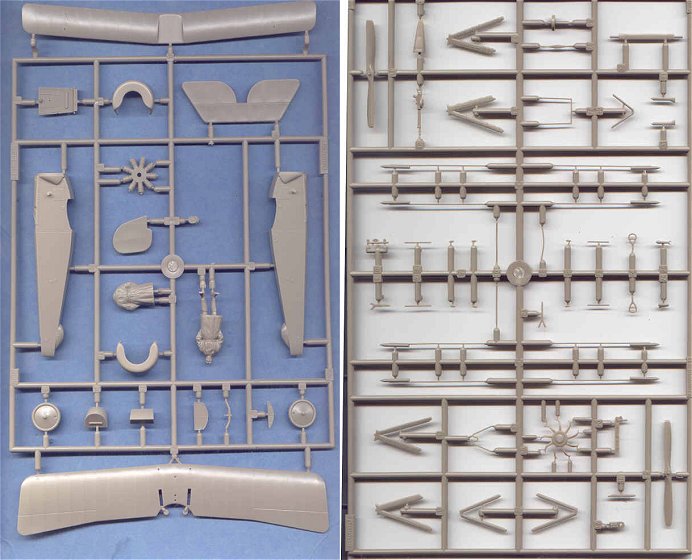
|
KIT: |
Eduard 1/48 Nieuport 11 Preview |
|
KIT # |
8069 |
|
PRICE: |
$24.95 |
|
DECALS: |
Two Aircraft |
|
REVIEW & |
|
|
NOTES: |
|

|
HISTORY |
The Nieuport 11, designed by Gustave Delage, emerged in 1915 as a smaller, single-seat version of the 2-seat Nieuport 10. The sesquiplane design, in which the lower wing is less than half the area of the upper, provided excellent maneuverability for a light-weight fighter powered by an 80 horsepower LeRhone 9C rotary engine. With its forward-firing Lewis gun mounted atop the wing to fire over the propeller arc, the "Bebe Nieuport" became the scourge of the "Fokker Scourge," driving the less-maneuverable German fighter from the skies during air battles over the Western Front in early 1916. At the Battle of Verdun, which began in February, 1916, eleven escadrilles of Nieuport 11s provided air superiority for the French, and every French ace flew the airplane. It was replaced in service by the Nieuport 17 that summer.
543 Nieuport 11s were manufactured under license in Italy by the Macchi-Nieuport and OEF companies; 200 were produced in Russia, where they were in use as late as 1922 during the Civil War. The airplane was flown by the Royal Flying Corps, the Belgian air force, and in Rumania, Serbia and the Ukraine. Escadrille 124, "The Escadrille Lafayette," was formed in April 1916 on Nieuport 11s.
|
THE KIT |

Eduard hasn't released a new World War I kit since their excellent Roland C.II last year. This new kit is completely up to the standard set by that kit. Eduard no longer makes limited-run kits, and this Nieuport can be favorably compared with anything released by Tamigawa.
 Molded on two sprues in light tan plastic, the parts are crisp and free of
flash; the wings still have the traditional "hills and valleys" meant
to represent fabric-covered wings, but the effect here is muted and looks good.
Markings are provided for two aircraft, one camouflaged and flown by the Count
de Plandes Sieyes de Veynes, and one the well-known "Zitomar!" with
its red-rooster fuselage insignia, flown by Paul Tarascon, and early French ace.
Molded on two sprues in light tan plastic, the parts are crisp and free of
flash; the wings still have the traditional "hills and valleys" meant
to represent fabric-covered wings, but the effect here is muted and looks good.
Markings are provided for two aircraft, one camouflaged and flown by the Count
de Plandes Sieyes de Veynes, and one the well-known "Zitomar!" with
its red-rooster fuselage insignia, flown by Paul Tarascon, and early French ace.
I particularly like the well-molded standing pilot figure the kit provides. Done in three parts, the pilot is wearing a long leather flying coat and will be useable in creating a diorama for display of the completed model.
The kit does not have any photo-etch parts, and quite frankly doens't need them.
|
CONCLUSIONS |
This kit has good production design, and looks to be a relatively simple project to complete. The Nieuport was not a "bird cage" of bracing wires, so if you have considered trying a World War I biplane model, this would be an excellent first project.
If you would like your product reviewed fairly and quickly by a site that averages over 2,800 visits a day, please contact me or see other details in the Note to Contributors.